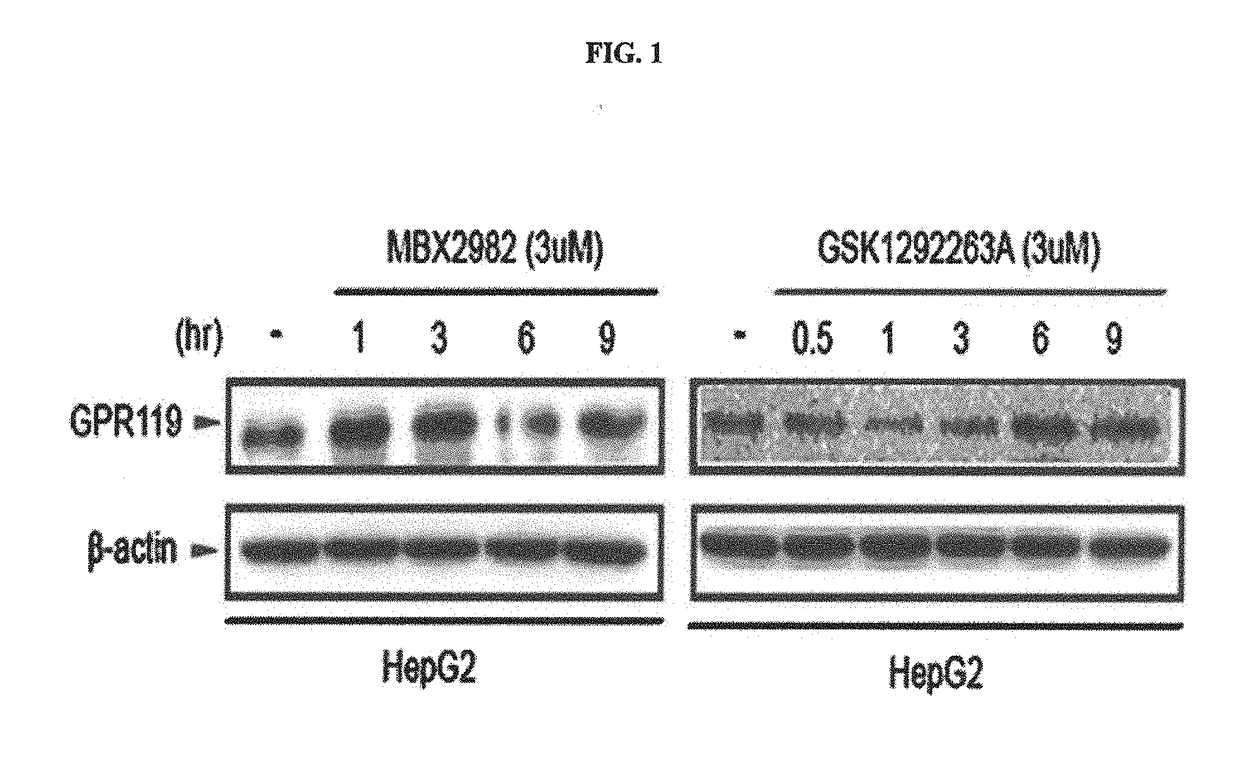Pharmaceutical composition containing gpr119 ligand as effective ingredient for preventing or treating non-alcoholic steatohepatitis
a technology of gpr119 and gpr119, which is applied in the direction of drug compositions, medical preparations, digestive systems, etc., can solve the problems of inability to provide target effects, high risk of developing cirrhosis, liver failure, liver cancer, etc., and achieve superior inhibition effect on inflammatory response, reduced expression of mcp-1 and tnf-alpha mrnas, and effective us
- Summary
- Abstract
- Description
- Claims
- Application Information
AI Technical Summary
Benefits of technology
Problems solved by technology
Method used
Image
Examples
example
Example 1. Expression Increase of GPR199 Receptor by GPR199 Ligand in Human Hepatocyte Line
[0094]In conventional studies, GPR119 expression in the liver was hardly observed. Accordingly, the function of a GPR119 ligand on fatty liver was not evaluated (Odori S et al., Metabolism, in press).
[0095]Accordingly, the present inventors confirmed that, when HepG2 (human liver cancer cell line) cells were treated with each of two selective GPR119 ligand types, i.e., MBX2982 and GSK1292263, GPR119 expression thereof was changed.
[0096]To perform this, a human hepatocyte line (HepG2) cultured according to the aforementioned methods B and C was treated with a 3 μM GPR119 ligand (MBX-2982, GSK-1292263A) in a time-dependent manner. Here, treatment conditions with the GPR119 ligand of each experimental group are summarized in [Table 3] and [Table 4] below. Expression level changes of the GPR119 protein were measured using the western blotting method of the aforementioned method D.
TABLE 3Human hepa...
example 2
n of SREBP-1c Activity and Fatty Acid Synthesis Enzyme Expression by GPR199 Ligand in Human Hepatocyte Line and Primary Mice Hepatocytes
[0098]Fatty acid synthesis involved in fatty liver development is related to expression increase in a series of an enzyme system as illustrated in FIG. 2. The expressions of acetyl-CoA carboxylase (ACC), fatty acid synthase (FAS), and stearoyl-CoA desaturase (SCD) of the enzyme system are controlled by a transcriptional factor, sterol regulatory element binding protein-1c (SREBP-1c). Activation of SREBP-1c causes expression of the enzyme system, thus facilitating the accumulation of triglycerides in the liver.
[0099]2-1. Investigation of SREBP-1c Expression Change by T0901317 Treatment
[0100]To investigate fat accumulation inhibition effects in the hepatocyte line treated with a GPR119 ligand, the present inventors first used a liver X receptor (LXR) ligand, i.e., T0901317 (N-(2,2,2-Trifluoroethyl)-N-[4-[2,2,2-trifluoro-1-hydroxy-1-(trifluoromethyl) e...
example 3
of GPR199 Ligand in Fatty Liver Model Induced by High-Fat Diet
[0111]To investigate whether the GPR119 ligands inhibited fatty liver development, the effects of the GPR119 ligand were investigated in a fatty liver model induced by a high-fat diet based on the animal experiment method of the method A.
[0112]Particularly, animals were fed with a high-fat diet for four weeks and then orally administered with the two drug types, the amount of each of which was 10 mg / kg, once per two days for additional four weeks under the high-fat diet condition. A particular experimental schedule is illustrated at an upper part of FIG. 7.
[0113]3-1. Investigation of Body Weight Decrease Effect
[0114]It was investigated whether, in the fatty live model induced by a high-fat diet, the body weights of the animals were reduced due to treatment with the GPR119 ligand.
[0115]As a result, it can be confirmed that the body weights of the animals fed with a high-fat diet are remarkably increased and the body weight...
PUM
| Property | Measurement | Unit |
|---|---|---|
| pH | aaaaa | aaaaa |
| thickness | aaaaa | aaaaa |
| wavelengths | aaaaa | aaaaa |
Abstract
Description
Claims
Application Information
 Login to View More
Login to View More - R&D
- Intellectual Property
- Life Sciences
- Materials
- Tech Scout
- Unparalleled Data Quality
- Higher Quality Content
- 60% Fewer Hallucinations
Browse by: Latest US Patents, China's latest patents, Technical Efficacy Thesaurus, Application Domain, Technology Topic, Popular Technical Reports.
© 2025 PatSnap. All rights reserved.Legal|Privacy policy|Modern Slavery Act Transparency Statement|Sitemap|About US| Contact US: help@patsnap.com



